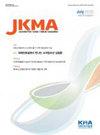过敏性结膜炎的诊断和药物治疗
IF 0.5
Q3 MEDICINE, GENERAL & INTERNAL
引用次数: 0
摘要
背景:过敏性结膜炎是一种主要由眼结膜1型超敏反应引起的免疫性疾病。根据临床表现和发病机制,变应性结膜炎可分为以下亚型:季节性变应性结膜炎、常年性变应性结膜炎、特应性角膜结膜炎、春季性角膜结膜炎和巨大乳头状结膜炎。当前概念:推荐的过敏性结膜炎初始治疗包括使用具有抗组胺和肥大细胞稳定作用的双效药物。如果在使用这些药物后症状仍然存在,共存的变应性鼻炎应该被认为是一个可能的因素,因为这种情况也会导致眼部症状。同时治疗变应性鼻炎是必要的。虽然口服抗组胺药能有效缓解与过敏性结膜炎相关的症状,但必须仔细考虑潜在的全身副作用,特别是对老年人和儿童。类固醇滴眼液的使用时间应有限,以尽量减少副作用。与季节性和常年性变应性结膜炎不同,春性角膜结膜炎、特应性角膜结膜炎和巨大乳头状结膜炎涉及T细胞介导的1型超敏反应和4型超敏反应。在双效剂或类固醇滴眼液不能产生改善的情况下,局部免疫抑制剂如环孢素A或他克莫司可以有效。讨论与结论:变应性结膜炎的药物治疗包括最初使用双效药物,如果存在变应性鼻炎,同时治疗。重要的是,特应性和春性角膜结膜炎可能导致永久性视力丧失,因此需要使用类固醇滴眼液或免疫抑制剂滴眼液。本文章由计算机程序翻译,如有差异,请以英文原文为准。
Diagnosis and pharmacological management of allergic conjunctivitis
Background: Allergic conjunctivitis is an immune disease primarily attributed to a type 1 hypersensitivity reaction in the conjunctiva of the eye. Based on clinical findings and pathogenesis, allergic conjunctivitis is classified into the following subtypes: seasonal allergic conjunctivitis, perennial allergic conjunctivitis, atopic keratoconjunctivitis, vernal keratoconjunctivitis, and giant papillary conjunctivitis.Current Concepts: The recommended initial treatment for allergic conjunctivitis involves the use of dual-effect agents exerting both antihistamine and mast cell stabilizing effects. If symptoms persist despite the application of these agents, coexisting allergic rhinitis should be considered a possible contributing factor, as this condition can also lead to ocular symptoms. Concurrent treatment of allergic rhinitis is necessary. Although oral antihistamines effectively alleviate symptoms associated with allergic conjunctivitis, potential systemic side effects must be carefully considered, particularly in older individuals and children. Steroid eye drops should be used for limited durations to minimize side effects. Unlike seasonal and perennial allergic conjunctivitis, vernal keratoconjunctivitis, atopic keratoconjunctivitis, and giant papillary conjunctivitis involve both type 1 hypersensitivity reactions and type 4 hypersensitivity mediated by T cells. In cases where dual-effect agents or steroid eye drops fail to yield improvements, topical immunosuppressants such as cyclosporine A or tacrolimus can be effective.Discussion and Conclusion: The pharmacological treatment of allergic conjunctivitis involves the initial use of dual-effect agents, with concurrent treatment of allergic rhinitis if present. Importantly, atopic and vernal keratoconjunctivitis can potentially lead to permanent vision loss, necessitating the application of steroid eye drops or immunosuppressant eye drops.
求助全文
通过发布文献求助,成功后即可免费获取论文全文。
去求助
来源期刊

Journal of The Korean Medical Association
Medicine-General Medicine
CiteScore
0.50
自引率
0.00%
发文量
84
审稿时长
4-8 weeks
期刊介绍:
The Journal of the Korean Medical Association (JKMA) is the official peer-reviewed, open-access, monthly journal of the Korean Medical Association (KMA). It contains articles in Korean or English. Its abbreviated title is ''J Korean Med Assoc''. The aims of the Journal include contributing to the treatment of and preventing diseases of public health importance and to improvement of health and quality of life through sharing the state-of the-art scientific information on medicine by the members of KMA and other national and international societies.
 求助内容:
求助内容: 应助结果提醒方式:
应助结果提醒方式:


